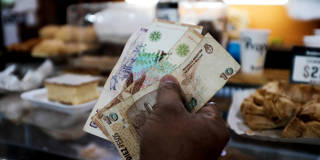KEUN LEE

SEOUL – As the world grapples with an inflationary surge fueled by the COVID-19 pandemic, Sino-American trade frictions, and the war in Ukraine, the United States has settled on its response: interest-rate hikes. But, while this may help the US beat back price growth, higher US interest rates intensify inflationary pressures for others, especially emerging economies.
By raising interest rates, the Federal Reserve is drawing capital toward the US economy, largely from emerging economies. As capital inflows drive up the dollar’s value, capital outflows are dragging down emerging-economy currencies. Since the beginning of this year, the South Korean won has depreciated by 18%, the Egyptian pound by 20%, the Thai baht by 15%, the Indian rupee by 8%, and the Chinese renminbi by 13%.
At the same time, inflation has soared in emerging economies. Nigeria’s inflation rate hit a 17-year high of 20.5% in August. In Egypt, inflation is approaching 15%. And in Argentina, it is forecast to exceed 100% this year. While US monetary policy is hardly the only factor, it is undoubtedly making matters worse.
Now, emerging economies face a policy dilemma. They can allow continued capital outflows and currency depreciation, and watch prices – especially of imported goods, including food – continue to climb. Or they can follow the US example and raise interest rates, effectively smothering the pandemic recovery in its crib. The more open an economy’s trade and capital markets are, the higher the costs of both options.
This dilemma is an outgrowth of the “impossible trilemma” in macroeconomics, which states that a country cannot simultaneously have a fixed exchange rate, free capital movement, and an independent monetary policy. This explains why a few countries with capital controls, like China, have been able to lower interest rates, thereby boosting the economy, while preventing the value of their currency from plummeting.
This is not an option for countries without capital controls, including advanced economies, though their currencies’ convertibility dampens the impact of US policy moves. To be sure, even advanced-economy central banks, from the Bank of England to the European Central Bank, are now raising their interest rates, and both the euro and the British pound have reached record lows against the US dollar. Nonetheless, emerging economies face far greater risks to financial stability, and have fewer policy options.

Financial liberalization used to be the standard policy prescription for developing countries. The International Monetary Fund and the World Bank touted liberalization as a way to attract more capital to economies that lacked domestic financial resources. In practice, however, the removal of capital controls was followed not by steady economic growth, but by financial crisis.
The 1997 Asian financial crisis is a case in point. As capital poured out of Indonesia, South Korea, and Thailand, the three governments were forced to request emergency loans from the IMF. Malaysia, by contrast, avoided this situation by imposing capital controls. This and similar crises gradually produced the understanding – eventually extending even to the IMF – of the dangers of “premature” financial liberalization.
Those dangers are compounded by the US dollar’s global preeminence. Countries around the world borrow, settle trade, and hold reserves in dollars. But the dollar remains a national currency, managed by a central bank whose mandate focuses on US inflation and employment.
Given the dollar’s global role, the US has a responsibility to support other economies at times of upheaval. This happened to some extent in March 2020. Responding to the initial pandemic shock, the US Federal Reserve Board extended currency swap lines to nine economies: Australia, Brazil, Denmark, Mexico, New Zealand, Norway, Singapore, South Korea, and Sweden.
This intervention – together with America’s standing currency-swap arrangements with Canada, the eurozone, Japan, Switzerland, and the United Kingdom – helped to stabilize the foreign-exchange market amid an explosion in demand for dollars. Such swap lines should be extended to all G20 countries today.
More broadly, ensuring global stability would require Fed policymakers to be more mindful of their decisions’ international repercussions. But this seems unlikely, leaving emerging economies with little choice but to attempt to limit their exposure to US policy, whether by reducing their use of dollars – a trend that is already underway – or by limiting capital mobility.
By imposing some constraints on capital markets, emerging economies could boost their exchange-rate stability and monetary-policy autonomy, thereby enhancing their leeway to make decisions that strengthen domestic investment and growth. Even the IMF has endorsed various capital controls and macroprudential policies.
South Korea offers a model for this approach. After the pandemic began and the dollar-swap line was established, the authorities adopted three measures – devised in the aftermath of the 2008 global financial crisis – to increase the flexibility of the dollar supply and cope with capital-flow volatility.
First, the Bank of Korea raised the cap on commercial banks’ foreign-currency forward positions – from 40% to 50% for local banks, and from 200% to 250% for foreign banks – to encourage them to provide more dollars. Second, taxes on non-deposit foreign-exchange debts held by commercial banks were suspended. Third, the liquidity coverage ratio was reduced from 100% to 85%.
Beyond adopting such macroprudential measures, emerging economies would be wise to consider more direct capital-account management. While the US accuses others of engaging in exchange-rate manipulation in order to promote exports, its interest-rate hikes amount to a similar manipulation, aimed at exporting inflation.
This approach is both unjust and unjustified, given that supply-side factors – for example, supply-chain disruptions caused by the US-China decoupling and the Ukraine war – are among the main drivers of today’s inflation. Interest rates are not the right tools for managing supply-side inflation. In fact, the weakness of many economies calls for lowering interest rates. But current US policy is making that all but impossible for countries with liberalized capital accounts.
No comments:
Post a Comment